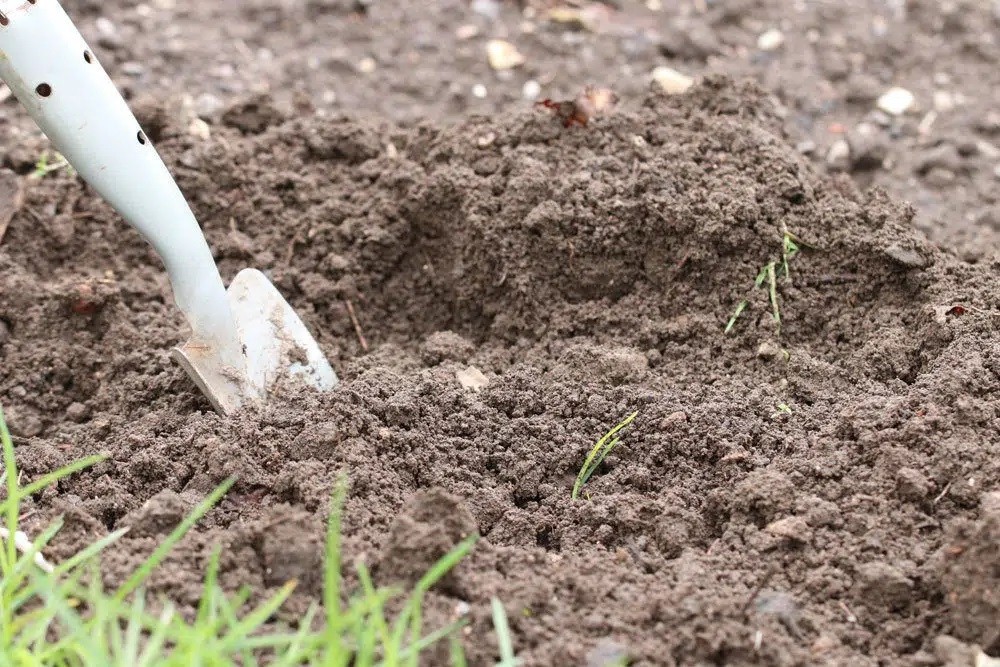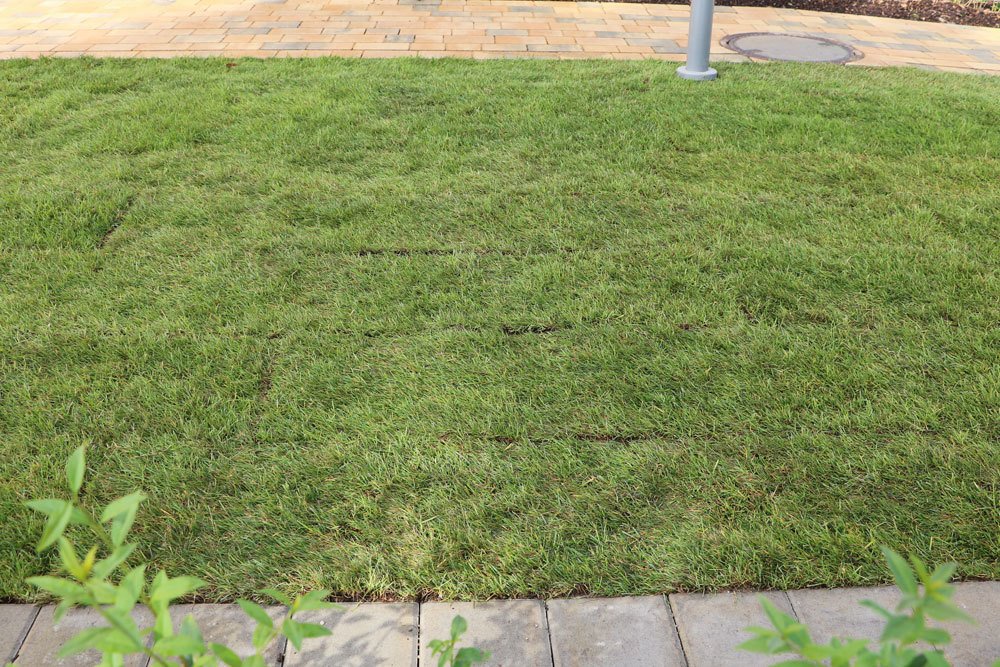The centerpiece of many gardens is a beautiful lawn – even after years. If the old lawn is worn out, sod can be laid on top of it with little effort and no complicated tools. We explain how it can be done.
- mow the old lawn as short as possible before installation
- test and improve the soil quality if necessary
- Rolled lawns need more time on old lawns until they are ready to be walked on than directly on soil
- Rolled turf requires less water after installation than a seeded turf, as the germination phase is omitted
Contents
- 1 Turf on old lawns?
- 2 Step 1 – Mowing and loosening up the soil
- 3 Step 3 – Leveling
- 4 Step 4 – Laying
- 5 Step 5 – Care
- 6 Frequently asked questions
- 7 Can the old lawn grow into the joints of the sod?
- 8 How much does the sandwich construction increase the ground level?
- 9 Does the damage to the old turf make a difference?
- 10 Does it make sense to apply a layer of sand on top of the old turf?
- 11 Author
Turf on old lawns?
Normally, plants need loose, fresh soil for successful growth. Already settled and sometimes depleted areas, on the other hand, are less suitable for new planting. And although the individual lawn plants are already fully developed in the case of rolled turf, they also need to make contact with the soil in the same way and anchor themselves there in depth. Therefore, laying sod on existing lawns is possible, but it is only optimal to a limited extent. The following problems can occur:
- high soil compaction due to previous lawn use
- consequently low water storage capacity of the soil
- as a result, difficult penetration of the new roots into the existing soil
- depleted soil due to similar use in the past
- unevenness occurring later due to decomposition of the old turf in the soil
Rolled turf requires less water after installation than a seeded turf, as the germination phase is omitted
Note: Surely there was a reason why your previous lawn did not thrive. Presumably, your sod will experience the same problems in the long run if you don’t identify the difficulties in advance and improve the conditions.
In return, you will find some clear advantages in laying the sod directly on the existing surface, the so-called sandwich construction method:
- low effort
- no removal of the old turf necessary
- no extensive soil preparation necessary or possible
Step by step to the sandwich construction method
If you have nevertheless decided to lay the rolled turf directly onto the existing lawn, you should take the following approach to heart in order to optimize the chances of success and to be able to complete the work quickly and with a reasonable amount of effort.
Tools and aids
- pH test strip
- depending on requirements, lawn lime or coniferous or oak compost
- Lawn mower or string trimmer
- Scarifier
- Rake
- garden soil or lawn substrate
- Knife
- Lawn roller
- Universal lawn fertilizer
- Garden hose and lawn sprinkler or circle sprinkler
- The approach
With these 5 steps, installation is guaranteed to succeed.
Step 1 – Mowing and loosening up the soil
First of all, create the necessary conditions for the subsoil, despite the remaining lawn layer, by eliminating the disadvantageous properties of the already overgrown soil as far as possible:
- Mow lawn at lowest cutting depth
- alternatively remove stalks with string trimmer at ground level
- Thoroughly remove and dispose of grass clippings
- Scarify the soil intensively with maximum working depth
- Thoroughly remove and dispose of loosened plant matter.
Note: The more organic plant matter you remove here, the less biomass can later rot under the sod. The probability of transferring the rot to the new sod, as well as uncontrolled settling due to the decomposition of the biomass are thus avoided as best as possible.
Step 2 – Soil improvement
Now prepare the soil to serve as a solid and reliable growth base for the new sod plants:
- Determine the soil pH using test strips and compare with the turf manufacturer’s specifications.
- if necessary, adjust the soil pH:
- acidic soil (too low pH-value) with lawn lime
- alkaline soil (too high pH-value) by acidic coniferous or oak compost
Spread the material on the scarified soil and water it intensively, then wait about one to two days before the next steps.
Apply universal lawn fertilizer according to the manufacturer’s instructions over the surface of the ground
Step 3 – Leveling
Although sandwich construction does not actually involve any intervention in the subsoil, it is now possible to fill any dents or depressions in the existing lawn:

- Fill up depressions with garden soil or lawn substrate
- Level surface with rake
- Press down the filling with a roller
- repeat procedure if necessary
Note: Be careful not to apply too thick a layer. Otherwise, perceptible settling is to be expected here due to the different soil density, so that dents appear again. If there are severe unevennesses, you should irrigate the filled soil intensively to support the settlement before installing the lawn.
Step 4 – Laying
Now lay the turf according to the manufacturer’s instructions:
Roll out strips side by side, tightly butted, starting from a straight edge of the lawn.
Cut out and fit strips to shrubs, fences and other “fixtures” with a knife
after laying, press the area well to the ground with a roller
finally, water the new lawn area intensively for several days
Note: Although a rolled lawn also needs a lot of water, especially at the beginning, the need is much lower than after sowing. Since the germination phase is omitted, daily watering is sufficient to maintain the basic moisture in the soil and stimulate root growth.
Step 5 – Care
In order for the sod to develop its roots sufficiently deep into the subsoil through the old turf, however, it must also be cared for and encouraged to grow intensively:
- Mow the lawn for the first time after about 4 weeks.
- do not mow to a depth of less than 5 to 6 centimeters
- subsequently mow regularly as a growth incentive
- Water regularly in the event of increasing drought
Ideally, fertilize twice a year in spring and autumn with universal fertilizer.
Note: Since the roots of the turf must first penetrate the old layer of turf on their way to the subsoil, the waiting time before it is ready for use is somewhat longer than for turf laid directly on soil. Add about two weeks to the normal period.
Frequently asked questions
Can the old lawn grow into the joints of the sod?
No, this is not possible. Since the old plants under the sod receive no light and limited air, they decompose. If the blades are not cut back strongly, they serve as food for rotting bacteria, which can then also attack the roots of the sod.
How much does the sandwich construction increase the ground level?
Since they do not change the old floor, to the old floor level is added about the thickness of the rolled turf. Usually this is about five centimeters. You should take into account the change in level especially at borders, terrace exits and other transitions.
Does the damage to the old turf make a difference?
Yes and no. Since the old turf mass rots in the soil anyway, it doesn’t matter how badly damaged the turf was before the new installation. However, the less living biomass that is still present, the lower the risk of rot. In the worst case, it can also infest the sod and damage the roots from below.
Does it make sense to apply a layer of sand on top of the old turf?
Although the sand allows the roots of the sod to develop quickly, this ends when the root veins encounter the barrier of the compacted subsoil in the existing turf. In addition, the sand layer is not capable of retaining water. A sustainable promotion of the rolled turf is therefore not to be expected.


